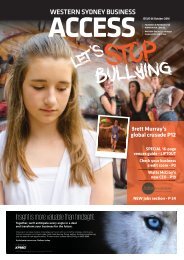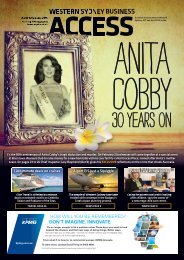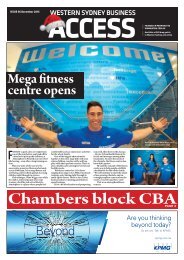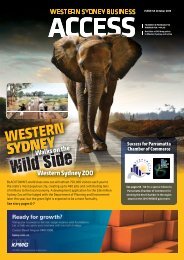RECRUITMENT
WSBA September 2015
WSBA September 2015
You also want an ePaper? Increase the reach of your titles
YUMPU automatically turns print PDFs into web optimized ePapers that Google loves.
CHILDSCENE<br />
WWW.WSBA.COM.AU<br />
Kids prefer maths when you let them<br />
figure out the answer for themselves<br />
CLASSROOM<br />
By Peter Sullivan<br />
Professor of Science, Mathematics and<br />
Technology Education at Monash University<br />
A<br />
COMMON view is that students learn<br />
maths best when teachers give clear<br />
explanations of mathematical concepts,<br />
usually in isolation from other concepts,<br />
and students are then given opportunities to<br />
practise what they have been shown.<br />
I’ve recently undertaken research at<br />
primary and junior secondary levels exploring<br />
a different approach. This approach involves<br />
posing questions like the following and<br />
expecting (in this case, primary level) students<br />
to work out their own approaches to the task<br />
for themselves prior to any instruction from<br />
the teacher:<br />
The minute hand of a clock is on two, and<br />
the hands make an acute angle. What might be<br />
the time?<br />
There are three ways that this question is<br />
different from conventional questions. First,<br />
it focuses on two aspects of mathematics<br />
together, time and angles.<br />
Contrasting two concepts helps students<br />
see connections and move beyond approaching<br />
mathematics as a collection of isolated facts.<br />
Questions posed to students as part of the<br />
research are different to conventional math<br />
problems.<br />
Second, the question has more than one<br />
correct answer. Having more than one correct<br />
answer means students have opportunities<br />
to make decisions about their own<br />
answer and then have something unique<br />
to contribute to discussions with other<br />
students.<br />
Third, students can respond at different<br />
levels of sophistication: some students might<br />
find just one answer, while other students<br />
might find all of the possibilities and formulate<br />
generalisations.<br />
The task is what is described as appropriately<br />
challenging. The solutions and solution<br />
pathways are not immediately obvious for<br />
middle primary students but the task draws on<br />
ideas with which they are familiar. An explicit<br />
advantage of posing such challenging tasks is<br />
that the need for students to apply themselves<br />
and persist is obvious to the students, even if<br />
the task seems daunting at first.<br />
Sharing insights and solutions<br />
After the students have worked on the task<br />
for a time, the teacher manages a discussion<br />
in which students share their insights and<br />
solutions.<br />
This is an important opportunity for students<br />
to see what other students have found,<br />
and especially to realise that in many cases<br />
there are multiple ways of solving mathematics<br />
problems.<br />
It is suggested to teachers that they use<br />
a data projector or similar technology to<br />
project students’ actual work. This saves time<br />
rewriting the work, presents the students’<br />
work authentically and illustrates to students<br />
the benefits of writing clearly and explaining<br />
thinking fully.<br />
Subsequently, the teacher poses a further<br />
task in which some aspects are kept the same<br />
and some aspects changed, such as:<br />
The minute hand of a clock is on eight, and<br />
the hands make an obtuse angle. What might<br />
be the time?<br />
The tasks given to students are appropriately<br />
challenging.<br />
The intention is that students learn from<br />
the thinking activated by working on the first<br />
task and from the class discussion, then apply<br />
that learning to the second task.<br />
The research aims to identify tasks that<br />
not only are appropriately challenging but<br />
can be adapted to suit the needs of particular<br />
students. For example, there may be some<br />
students for whom the first task is too difficult.<br />
Those students might be asked to work on a<br />
question like:<br />
What is a time at which the hands of a<br />
clock make an acute angle?<br />
The intention is that those students<br />
then have more chance of engaging with the<br />
original task. Of course, there are also students<br />
who can find answers quickly and are then<br />
ready for further challenges. Those students<br />
might be posed questions like:<br />
With the minute hand on two, why are<br />
there six times for which the hands make an<br />
acute angle? Is there a number to which the<br />
minute hand might point for which there are<br />
not six possibilities?<br />
There might even be advanced students<br />
who could be asked: What are some times<br />
for which the hands on a clock make a right<br />
angle?<br />
The combination of the students’ own engagement<br />
with the problem and the different<br />
levels of prompts means the students’ work<br />
contains rich and useful information about<br />
what the students know. Teachers can use this<br />
not only to give the students feedback but also<br />
to plan subsequent teaching.<br />
Students welcomed the challenge<br />
The project found that students prefer to<br />
work out solutions and representations by<br />
themselves or with other students.<br />
The project found that, contrary to the<br />
preconceptions of some teachers, many students<br />
do not fear challenges in mathematics<br />
but welcome them.<br />
Rather than preferring teachers to instruct<br />
them on solution methods, many students<br />
prefer to work out solutions by themselves or<br />
by working with other students.<br />
The project also established that students<br />
learn substantive mathematics content from<br />
working on challenging tasks and are willing<br />
and able to develop ways of articulating their<br />
reasoning.<br />
THIS ARTICLE WAS FIRST PUBLISHED AT WWW.THECONVERSATION.COM.AU<br />
48 WESTERN SYDNEY BUSINESS ACCESS SEPTEMBER 2015






